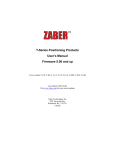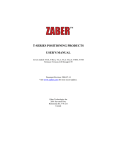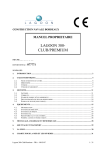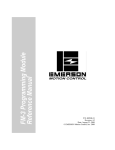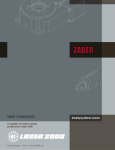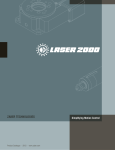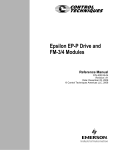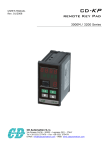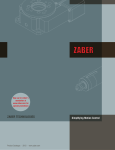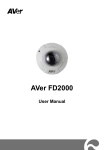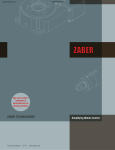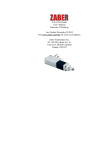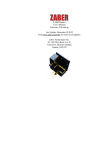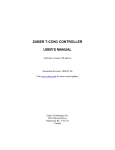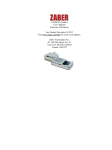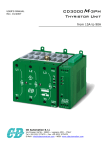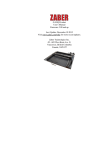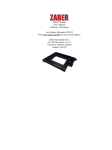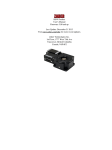Download - Zaber Technologies Inc
Transcript
T-SERIES POSITIONING PRODUCTS USER’S MANUAL Covers models T-CD, T-HLA, T-LA, T-LS, T-LLS, T-MM, T-NM Firmware Versions 3.00 through 4.99 Document Revision: 2006-07-17 Visit www.zaber.com for more recent updates. Zaber Technologies Inc 2891 Steveston Hwy Richmond, BC, V7E 2J1 Canada Contents 1. 1.1. 1.2. 2. 3. 4. 5. 5.1. 5.2. 5.3. 6. 7. 8. 8.1. 8.2. 8.3. 8.4. 8.5. 8.6. 8.7. 8.8. 8.9. 8.10. 8.11. 8.12. 8.13. 8.14. 8.15. 8.16. 8.17. 8.18. 8.19. 8.20. 8.21. 8.22. 8.23. 8.24. 8.25. 8.26. 8.27. 8.28. 9. 9.1. 9.2. 9.3. 9.4. 10. 10.1. 10.2. 10.3. 10.4. 10.5. 10.6. ZABER T-SERIES POSITIONING PRODUCTS............................................................................... 4 Series Specifications ..................................................................................................................... 5 Device Specifications.................................................................................................................... 5 FIRMWARE VERSION INFORMATION ......................................................................................... 6 CAUTION............................................................................................................................................ 6 INITIAL SETUP AND TESTING....................................................................................................... 6 INSTALLATION................................................................................................................................. 7 Connection to a Computer ........................................................................................................... 7 Linear Actuator Products (T-LA and T-HLA series).................................................................... 8 Vacuum Compatible Devices........................................................................................................ 8 CONTROL THROUGH THE RS232 PORT....................................................................................... 9 COMMAND QUICK REFERENCE ................................................................................................. 10 DETAILED COMMAND REFERENCE .......................................................................................... 12 Reset (#0) .................................................................................................................................... 12 Home (#1) ................................................................................................................................... 12 Renumber (#2) ............................................................................................................................ 13 Move Absolute (#20) .................................................................................................................. 13 Move Relative (#21) ................................................................................................................... 14 Move at Constant Speed (#22).................................................................................................... 14 Stop (#23).................................................................................................................................... 15 Set Home Sensor Scan Distance (#34)........................................................................................ 15 Read/Write EEprom (#35) .......................................................................................................... 16 Restore factory default settings (#36) ......................................................................................... 16 Set Micro-Step Resolution (#37) ................................................................................................ 17 Set Running Current (#38) & Set Hold Current (#39) ................................................................ 18 Set Device Mode (#40) ............................................................................................................... 19 Set Start Speed (#41)................................................................................................................... 21 Set Target Speed (#42)................................................................................................................ 21 Set Acceleration (#43) ................................................................................................................ 22 Set Range (#44)........................................................................................................................... 23 Set Current Position (#45)........................................................................................................... 23 Set Maximum Relative Move (#46)............................................................................................ 23 Set Home Offset (#47) ................................................................................................................ 24 Set Alias (#48) ............................................................................................................................ 24 Set Home Speed (#49) ................................................................................................................ 25 Return Device ID (#50)............................................................................................................... 25 Return Firmware Version (#51) .................................................................................................. 25 Return Power Supply Voltage (#52) ........................................................................................... 26 Return Setting (#53).................................................................................................................... 26 Return Status (#54) ..................................................................................................................... 26 Return Current Position (#60)..................................................................................................... 27 REPLY-ONLY COMMAND REFERENCE..................................................................................... 28 Reply #8 – Position tracking during instructed move ................................................................. 28 Reply #10 – Position tracking during manual move ................................................................... 28 Reply #14 – Power supply voltage out of range ......................................................................... 28 Reply #255 – Error...................................................................................................................... 29 DEVICE SPECIFIC INFORMATION .............................................................................................. 30 T-CD Series – Chopper drive stepper controller......................................................................... 30 T-HLA Series – Heavy duty linear actuators .............................................................................. 34 T-LA Series – Linear actuators ................................................................................................... 34 T-LLS Series – Long travel linear slides .................................................................................... 34 T-LS – Linear stages ................................................................................................................... 35 T-NM – NEMA stepper motors with built in controllers............................................................ 35 ______________________________________________________________________________________ Copyright © Zaber Technologies Inc. Page 2 of 43 10.7. 11. 12. 13. 14. 15. 16. 17. 18. T-MM2 – 2 axis motorized mirror mounts ................................................................................. 37 MANUAL CONTROL AND LED INDICATORS ........................................................................... 38 TROUBLESHOOTING ..................................................................................................................... 39 DATA CABLE PINOUT DIAGRAM ............................................................................................... 41 WARRANTY..................................................................................................................................... 42 REPAIRS ........................................................................................................................................... 42 EMAIL UPDATES ............................................................................................................................ 42 DISCLAIMER ................................................................................................................................... 42 TECHNICAL SUPPORT AND CONTACT ..................................................................................... 42 ______________________________________________________________________________________ Copyright © Zaber Technologies Inc. Page 3 of 43 1. ZABER T-SERIES POSITIONING PRODUCTS T-LA Series – Linear Actuators T-HLA Series – Heavy Duty Linear Actuators T-LS Series – Linear Stages T-LLS Series – Long Travel Linear Slides T-MM Series – Motorized Mirror Mounts T-NM Series – Steppers with built in Controllers T-CON Series – Stand-alone Controller T-CD Series – Chopper Drive Stepper Controller Product Updates: If you would like to receive our quarterly email newsletter with product updates and promotions, please sign up at http://www.zaber.com (news section). ______________________________________________________________________________________ Copyright © Zaber Technologies Inc. Page 4 of 43 1.1. Series Specifications Power Supply: 12V nominal (12V to 16V acceptable) DC unregulated supply on 2.1 mm, center positive power connector. Note that voltage will affect available thrust. Communications: RS232, 9600 baud, no parity, one stop bit on 6-pin mini din cable (PS/2) male towards the computer, female towards the next unit 1.2. Device Specifications Part # Range Resolution Repeatability Accuracy Backlash T-LS13 13 mm 0.1 um <0.4 um <12 um <4 um T-LA28 T-HLA28 T-LS28 28 mm 0.1 um <0.4 um <12 um <4 um T-LA60 60 mm 0.1 um <0.4 um <16 um <4 um T-LS80 80 mm 0.1 um <0.4 um <16 um <4 um T-LLS105 105 mm 0.16 um <0.5 um <16 um <16 um T-LLS260 260 mm 0.16 um <0.5 um <20 um <16 um T-MM2 -5.5° to +5.0° 1.5 mrad <7 urad <180 urad <15 urad T-NM N/A 0.028° <0.1° <1.0° N/A Part # Stall Load * Max Speed * Current Draw Mounting Interface Manual Control T-LS13 T-LS28 T-LS80 60 N 4 mm/s 320 mA ¼”-20 or M6 holes Yes T-LA28A T-LA60A 40 N 4 mm/s 320 mA 3/8-32 threaded shank Yes T-HLA28 60 N 4 mm/s 500 mA 3/8-32 threaded shank Yes T-LLS105 T-LLS260 93 N 6 mm/s 800 mA #5-40 holes Yes T-MM2 40 N 60 mrad/s 600 mA ¼”-20 (M6 adapter available) Yes T-NM 2100 g-cm 180 rpm 900 mA M3 holes, 5mm shaft Yes T-XXXX-S All part numbers are available with the “-S” suffix. These parts are identical to the standard part except that they have no manual control. No * Thrust is a function of speed. These values cannot both be achieved simultaneously (i.e. at maximum speed, the unit will stall at a load of about 1/3 the indicated stall load). ______________________________________________________________________________________ Copyright © Zaber Technologies Inc. Page 5 of 43 2. FIRMWARE VERSION INFORMATION The version of firmware installed on any Zaber T-Series device can be determined by issuing command #51. A 3 digit number will be returned. Assume 2 decimal places (ex a reply of 293 indicates firmware version 2.93). This user’s manual applies only to devices with firmware version 3.00 through 4.99. Newer firmware versions may be available. Due to the addition of new features, newer versions of firmware may not be 100% compatible with older versions. For more information on firmware versions that may have been released since the printing of this manual, please check the support section of Zaber’s website where user’s manuals for all versions of firmware are posted for download. You may also wish to read the document “Zaber T-Series Firmware History and Migration” which should be posted on Zaber’s website as well and updated regularly. This document specifies what version of firmware currently ships standard on each device, as well as outlining the changes that have taken place from one firmware version to the next and indicating what options are available if you wish to upgrade or downgrade the firmware on your devices. 3. CAUTION Zaber’s positioning devices are precision instruments and must be handled with care. In particular, leadscrews must be treated with care. Axial loads in excess of the stall load, axial and radial impact, dust and other contaminants and damage to the leadscrew thread will reduce the performance of the unit below stated specifications. Performance depends very much on the condition of the leadscrew. On actuators such as the T-LA and T-HLA series, the plunger should always be left in the fully retracted position (home) when not in use. This protects the leadscrew from the environment. The leadscrew may be cleaned periodically for best results. To clean the screw, first use methanol to dissolve old grease and contaminants. There are plastic components that may be damaged by some strong solvents. A small amount of silicon based grease should be applied to reduce friction, backlash and sticktion. For vacuum applications we recommend NyeTorr 5300 silicon based vacuum grease available from www.nyelubricants.com. 4. INITIAL SETUP AND TESTING If you are unfamiliar with T-series devices, you may wish to perform a few simple steps to familiarize yourself with their operation. First you will need a power supply. If you ordered one with your device you shouldn’t have any problems. If not, you will require a power supply with output voltage between 12 and 16V. The power input accepts a standard 2.1mm center positive connector. Most 12V AC to DC adapters output around 16V under light current draw, dropping to 12V at their rated current. Some may output higher voltages and will not be suitable. The chosen power supply must be also be rated to handle the maximum total current draw of the devices connected to it. For example, if you have two T-LA units chained together with a single power supply, you will need at least 640 mA (320 mA per actuator, x 2). When powering long chains of devices, we recommend connecting a power supply to at least every 2nd device in the chain to reduce the current through the data cables. When connecting several units in a daisy chain, first connect the units to one another. Then only apply power when all of the units are connected properly. Once you have a working power supply, you can test the operation of your device. If you have a device with manual adjustment, turn the potentiometer counterclockwise to home the device. When operating manually, you must home the device every time you disconnect or turn off the power. You will not be able to achieve the maximum travel until you have homed the device. After the unit retracts completely it will stop automatically and you can turn the potentiometer clockwise to extend the device. ______________________________________________________________________________________ Copyright © Zaber Technologies Inc. Page 6 of 43 If you have a T-xxxx-S model you cannot control the unit manually. Instead you must install the device on a computer. See the next section for information on how to do this. 5. INSTALLATION 5.1. Connection to a Computer Connecting Zaber devices to a computer is a very simple process: Step 1. Plug the Mini-DIN to D-Sub serial adapter into your computer’s serial port and plug the device’s data cable into the adapter. You may need to use a cable extension to reach your computer. There is no need to power-down or reboot the computer. USB-to-RS232 converters are available if you have no RS232 serial port. Step 2. Connect the power plug of your power supply (2.1mm center positive) to the power connector of the device. The green LED should light indicating the unit has power. Step 3. Install a demo program from the included CD, or download one from the support section of our website http://www.zaber.com. Follow the instructions in the readme file to install and run the program. As a simple first test, try entering these instructions: Unit 0 1 Cmd 2 1 Data 0 0 Additional Devices. Additional units can simply be daisy-chained to the first. For long chains, a power supply should be connected at every 3rd unit. A renumber command needs to be issued after a new unit is connected before it can be controlled independently from the demo program. ______________________________________________________________________________________ Copyright © Zaber Technologies Inc. Page 7 of 43 Description Renumber Home 5.2. Linear Actuator Products (T-LA and T-HLA series) When mounting linear actuators, care must be taken not to over-constrain the leadscrew. At the point of contact of the leadscrew with the object to be moved there are 6 degrees of freedom which can be constrained: translation along xyz axes and rotation about those axes. The load should constrain only the axial translation of the leadscrew. The simplest way to achieve this is to have the lead screw press against a flat surface perpendicular to the axis of the leadscrew. Any further constraint (such as rigidly fixing the leadscrew to the load) may result in an over-constrained system that will reduce thrust or cause the leadscrew to bind. 5.3. Vacuum Compatible Devices Zaber’s vacuum compatible devices (devices with the suffix “-V” in the part number are identical in appearance and function to their non-vacuum compatible counterparts with the following exceptions: Lubrication: All lubricated interfaces (motor bearings, leadscrews, leadnuts, etc) are cleaned and regreased using a vacuum compatible lubricating gel (NyeTorr 5300, vapor pressure ~5x10-9 Torr at 25°C). We make every effort to remove all trace of the original greases (some components arrive from our manufacturers preassembled, and pre-greased) but for best results we recommend degassing the units before use in the final application. Power: No power connectors are provided on vacuum compatible devices. Instead, the power must be supplied through the data cable lines. A special serial adapter with power input is provided. Data cable extensions: Vacuum compatible devices use the same mini-din cable extensions as our standard devices; however, the cable jacket is stripped back to the connectors to expose the individual wires. The mini-din connectors are left attached to facilitate easy testing. In your final application you can cut the wires and splice them to a feed-through on your vacuum chamber. Communication lines can be wired back to the appropriate mini-din connector outside your vacuum chamber. Power lines can be wired to any appropriate power supply. See the table below for pinouts. If you have multiple units inside the same vacuum chamber you may connect them using the attached mini-din connectors, or for improved vacuum compatibility you may remove the connectors and permanently wire the units together. ______________________________________________________________________________________ Copyright © Zaber Technologies Inc. Page 8 of 43 6. CONTROL THROUGH THE RS232 PORT Your communications settings must be: 9600 baud, no hand shaking, 8 data bits, no parity, one stop bit. The amber LED will light when there is activity on the RS232 lines. You can use this feature to try to determine which COM port you are connected to. We recommend using the sample Visual Basic program included with Zaber products. It also contains source code that you can use as an example for writing your own code to control your specific system. Important: After power-up, the units in the chain will each initialize themselves as unit #1 and thus they will each execute the same instructions. To assign each unit a unique identifier you must issue a renumber instruction after all the units in the chain are powered up and every time you add or remove a unit from the chain. You must not transmit any instructions while the chain is renumbering or the renumbering routine may be corrupted. Renumbering takes less than a second, after which you may start issuing instructions over the RS232 connection. All instructions consist of a group of 6 bytes. They must be transmitted with less than 10 ms between each byte. If the unit has received less than 6 bytes and then a period longer than 10 ms passes, it ignores the bytes already received. We recommended that your software behave similarly when receiving data from the devices, especially in a noisy environment like a pulsed laser lab. The following table shows the instruction format: Byte 1 Unit # Byte 2 Command # Byte 3 Data (least significant byte) Byte 4 Data Byte 5 Data Byte 6 Data (most significant byte) The first byte is the unit number in the chain. Unit number 1 is the closest unit to the computer and unit number 2 is next and so forth. If the number 0 is used, all the units in the chain will execute the accompanying command simultaneously. The second byte is the command number. Bytes 3, 4, 5, and 6 are data in long integer, 2’s complement format with the least significant byte transmitted first. How the data bytes are interpreted depends on the command. Complete details are given in the command reference on the following page. Examples: Renumber all units: 0x00, 0x02, 0x00, 0x00, 0x00, 0x00 Home all units: 0x00, 0x01, 0x00, 0x00, 0x00, 0x00 Move unit #1 to an absolute position (command 20) of 257 micro-steps: 0x01, 0x14, 0x01, 0x01, 0x00, 0x00 Move unit #2 to a relative position (command 21) of -1 micro-steps: 0x02, 0x15, 0xFF, 0xFF, 0xFF, 0xFF If you are using Zaber’s demo software, you will only see 3 entry fields: Unit#, Command#, and Data. The Unit# and Command# fields accept integer values while the value you enter into the Data field can be signed. The value in the data field is converted by the software to 4 separate bytes and then gets sent to the unit. Most instructions cause the unit to reply with a return code. It is also a group of 6 bytes. The first byte is the device #. Byte #2 is the instruction just completed or 255 (0xFF) if an error occurs. Bytes 3,4,5 and 6 are data bytes in the same format as the instruction data byte. ______________________________________________________________________________________ Copyright © Zaber Technologies Inc. Page 9 of 43 7. COMMAND QUICK REFERENCE The command quick references below provide a list of available commands at a glance. A Detailed description of each command is given in the following section. Command Quick Reference for Firmware version 4.21 Command Reset Home Renumber* Move absolute Move relative Move at constant speed Stop Set home sensor scan distance* Read/write EEprom* Restore default settings* Set micro-step resolution* Set running current* Set hold current* Set device mode* Set start speed* Set target speed* Set acceleration* Set maximum travel range* Set current position Set maximum relative move* Set home offset* Set alias* Set home speed* Return device ID Return firmware version Return power supply voltage Return setting Return status Return current position # 0 1 2 20 21 22 23 34 35 36 37 38 39 40 41 42 43 44 45 46 47 48 49 50 51 52 53 54 60 Data Bytes Ignored Ignored Ignored Absolute position Relative position Speed setting Ignored Home sensor scan distance setting See detailed reference Ignored Micro-step resolution setting Running current setting Hold current setting Mode configuration (see below) Maximum step time setting Target micro-step period Acceleration setting Range in micro-steps New current position Maximum relative move Home offset in micro-steps Alias unit number Homing micro-step period Ignored Ignored Ignored Setting Number Ignored Ignored Reply Data None Absolute position Device ID Absolute position Absolute position Echo of command data Absolute position Echo of command data Pg 12 12 13 13 14 14 15 15 See detailed reference Echo of command data Echo of command data Echo of command data Echo of command data Echo of command data Echo of command data Echo of command data Echo of command data Echo of command data Echo of command data Echo of command data Echo of command data Echo of command data Echo of command data Device ID Firmware Version Power supply voltage Byte2: Setting number Byte3: Setting value Move status Absolute position 16 16 17 18 18 19 21 21 22 23 23 23 24 24 25 25 25 26 26 26 27 * The settings for these commands are saved in non-volatile memory, i.e. the setting persists even if the device is powered down. To restore all settings to factory defaults, use command 36. ______________________________________________________________________________________ Copyright © Zaber Technologies Inc. Page 10 of 43 Command #40, “Set mode” Options in Firmware version 4.21. See page 19 for more details. Data bits 0 (1s) Option Name Disable Auto-reply 1 2 3 4 (2s) (4s) (8s) (16s) Enable Anti-backlash Enable Anti-sticktion Disable Potentiometer Enable Position Tracking 5 (32s) 7 (128s) Disable Manual Position Tracking Enable Logical Channels Communications Mode Home Status 8 (256s) Disable Auto Home Feature 9 (512s 10(1024s) Reserved Enable Fast Decay Mode 11(2048s) Enable Circular Phase Microstepping Home Active High Reserved Disable Power LED Disable Serial LED 6 (64s) 12 (4096s) 13 (8192s) 14 (16384s) 15 (32768s) Effect Disables ALL replies except to commands 50 and higher Enables the anti-backlash mode Enables the anti-sticktion mode Disables the potentiometer Enables position replies during constant speed commands Disables automatic position replies during manual moves Enables the Logical Channels Communications Mode (see manual for more details) Read-only. Cleared on power up. Gets set automatically when device homes or position is set with command #45. Disables monitoring of the home limit sensor during moves except for a home instruction. Useful for allowing multiple revolutions on rotational devices. This bit is not used at this time. Enables fast decay control of PWM chopper current in the chopper driver units. Selects circular or square phase micro-stepping. Enable active high detection of home switch. This bit is not used at this time. Disables the power LED during operation. Disables the serial LED during operation. Reply-Only Commands in Firmware version 4.21 Reply Constant speed position tracking Manual move position tracking Power supply voltage out of range Command data out of range # 8 10 14 255 Data Bytes N/A. Reply-only N/A. Reply-only N/A. Reply-only N/A. Reply-only Reply Data Current absolute position Current absolute position Power supply voltage Current absolute position Pg 28 28 28 29 ______________________________________________________________________________________ Copyright © Zaber Technologies Inc. Page 11 of 43 8. DETAILED COMMAND REFERENCE Note that these commands apply only to firmware versions 3.00 through 4.99. To determine which version of firmware you have simply issue the “return firmware version” command (51). Many of the commands described below will work with other firmware versions, however behavior may differ. See the appropriate user’s manual for the version of firmware on your device. 8.1. Reset (#0) Firmware Version: Command Number: Data Bytes: Reply Data: All 0 Ignored None Behavior: This sets the device to its power-up condition. It has the same effect as unplugging and restarting the unit. The position stored in the device prior to this command will be lost, so you must save it and reload it if it is important. 8.2. Home (#1) Firmware Version: Command Number: Data Bytes: Reply Data: All 1 Ignored Absolute position (in this case 0) Behavior: The device retracts until it triggers its internal home switch. It then moves forward several steps to avoid accidentally triggering the home switch during use. If a home offset has been specified with the “Set Home Offset” instruction, the device will extend the additional amount specified. It will then stop and call this position 0. ______________________________________________________________________________________ Copyright © Zaber Technologies Inc. Page 12 of 43 8.3. Renumber (#2) Firmware Version: Command Number: Data Bytes: Reply Data: 3.07 and up 2 If issued to all units: ignored If issued to a single unit: new number Each unit affected replies with its device ID after renumbering. Firmware Version: Command Number: Data Bytes: Reply Data: 3.00 to 3.06 2 Ignored Each unit affected replies with its device ID after renumbering. Behavior (version 3.07 and up): If issued with a 0 in Byte 1, the data bytes are ignored and all units will renumber. The unit closest to the computer becomes number 1. The next unit becomes 2 and so forth. If issued with a number other than 0 in byte 1, the specified unit will reassign itself the unit number specified in the data bytes. Renumbering takes about 1/2 a second during which time the computer must not send any further data. The unit number is stored in non-volatile memory so you can renumber once and not worry about issuing the renumber instruction on each power-up. Behavior (version 3.00 to 3.06): In these earlier firmware versions, the renumber command will only be accepted if issued to all units (0 in byte 1). If issued to a single unit, the command will be ignored. Data bytes are always ignored. The unit number is stored in non-volatile memory so you can renumber once and not worry about issuing the renumber instruction on each power-up. 8.4. Move Absolute (#20) Firmware Version: Command Number: Data Bytes: Reply Data: All 20 Absolute position in micro-steps. Absolute position after the move is finished. Behavior: The device moves to the position given by the data bytes. The position must be within the acceptable range for the device or an error code will be returned. All move commands are pre-emptive. If a new move command is issued before the previous move command is finished, the device will immediately move to the new position. ______________________________________________________________________________________ Copyright © Zaber Technologies Inc. Page 13 of 43 8.5. Move Relative (#21) Firmware Version: Command Number: Data Bytes: Reply Data: All 21 Relative position (can be negative) in micro-steps. Absolute position after the move is finished. Behavior: The device moves to the position given by its position before the command plus the value in the data bytes. The final position must be within the acceptable range for the device or an error code will be returned. 8.6. Move at Constant Speed (#22) Firmware Version: Command Number: Data Bytes: Reply Data: All 22 Desired speed specified as the duration of a single micro-step in increments of 0.1 microseconds. per micro-step (negative values cause retraction, positive values extend). The current position is returned at the start of the move. The unit may also be set to return its position continuously during the move using the set mode command (#40) bit 4. The new position is returned at the end of the move. Behavior (version 4.19 and up): This instruction specifies a direction and a speed to move, rather than a target position. When this instruction is issued the device will accelerate (at a rate determined by command #43 Set Acceleration) to the speed specified by the instruction data. The device will continue moving at this speed until a limit is reached or a pre-empting instruction is issued. Negative speeds cause retraction whiile positive speeds cause extension. Data is valid from –8388607 to 8388607. To determine the speed that will result from a given data value, the following formulas may be used: Speed 10 7 Data 10 7 = R × Data 60 × 10 7 = S × R × Data = [microsteps/sec] or [steps/sec] or [revolutions/min] Where: Data is the absolute value of the Constant Speed Move instruction data R (micro-steps/step) is the micro-step resolution (command 37) S (steps/revolution) is the number of steps per revolution of the motor For example, if S = 48, R = 64, and the Constant Speed Move instruction is issued with Data of 365, then the device will move forward at a speed of approximately 535 revolutions per minute. For linear devices consult Appendix A to determine the linear distance corresponding to a single step or revolution. ______________________________________________________________________________________ Copyright © Zaber Technologies Inc. Page 14 of 43 8.7. Stop (#23) Firmware Version: Command Number: Data Bytes: Reply Data: All 23 Ignored. Current absolute position. Behavior: This instruction can be used to pre-empt any move instruction. The unit will decelerate (at a rate determined by command #43 Set Acceleration) and stop. 8.8. Set Home Sensor Scan Distance (#34) Firmware Version: Command Number: Data Bytes: Reply Data: Default Value: 4.17 and up 34 Byte 3 and 4 specify the number of full steps to scan forward for second home sensor signal after initial triggering of the home sensor. Bytes 5 and 6 are ignored. Reply data is simply an echo of the command data. 0 Behavior (version 4.17 and up): This command is only used with T-CD series of chopper driver controllers. This is a rarely used setting and most applications can safely leave it at the default value. When the home sensor is triggered, the unit will move forward until the home sensor deactivates. It will then move forward further by the Home Sensor Scan Distance. If the home sensor reactivates within that distance, the process is repeated. If the home sensor does not reactivate within the Home Sensor Scan Distance, the unit retracts to the point where the home sensor deactivated and sets this position to 0. This setting is useful if a custom home sensor is used to detect a magnet mounted to the side of a rotating and translating leadscrew such that the magnet follows a helical path and may pass in front of the home sensor multiple times. If the first pass is not detected properly (perhaps due to too high a speed), setting the Home Sensor Scan Distance to a value equivalent to at least one full revolution of the leadscrew will ensure a repeatable home position. In applications where there is no possibility of the home sensor triggering multiple times, this setting can safely be left as 0. Behavior (version 3.00 to 4.16): Not implemented. ______________________________________________________________________________________ Copyright © Zaber Technologies Inc. Page 15 of 43 8.9. Read/Write EEprom (#35) Firmware Version: Command Number: Data Bytes: Reply Data: All 35 Byte 3 specifies the address and action to be performed (read or write). Byte 4 specifies the data to write (it is ignored for reads). Bytes 5 and 6 are ignored. The reply data is simply an echo of the command data except that byte 4 contains the data read from the specified address Behavior: This command is used to read or write a byte of non-volatile memory. 128 bytes of EEPROM memory are available for user data. For example, the user may want to save some custom data such as a serial number, a name string, or data that uniquely identifies a particular device. Data written is not cleared by power down or reset. The most significant bit of byte 3 specifies whether the instruction is a read (0) or a write (1). The least significant 7 bits of byte 3 specify the address to read/write (0 to 127). Byte 4 specifies the value to be written. 8.10. Restore factory default settings (#36) Firmware Version: Command Number: Data Bytes: Reply Data: All 36 Ignored. Reply data is simply an echo of the command data Behavior: This command changes all settings back to their factory default values. ______________________________________________________________________________________ Copyright © Zaber Technologies Inc. Page 16 of 43 8.11. Set Micro-Step Resolution (#37) Firmware Version: Command Number: Data Bytes: Reply Data: Default Value: 4.15 and up 37 Byte 3 is the micro-step resolution in units of 1ustep/step. All other bytes are ignored. Setting saved in EEPROM (Non-volatile) Reply data is simply an echo of the command data Depends on device (see Appendix A) Behavior (version 4.15 and up): This setting changes the number of micro-steps per step. Valid data are 1, 2, 4, 8, 16, 32, 64, and 128. The default on most devices is 64. All position data sent to or received from T-Series products is in units of micro-steps. Note that when you change the micro-step resolution using this command, other position related settings are changed automatically to adjust for the new micro-step size. The table below gives an example showing how other settings are affected when the micro-step resolution is changed from 128 to 64. Example of settings affected when Micro-step Resolution is changed from 128 to 64 Setting Target Speed (micro-step period)* Maximum Travel Range* Current Position Maximum Relative Move* Home Offset Distance* Before 365 280000 10501** 20000 100 After 730 140000 5250** 10000 50 * The setting for these command is saved in non-volatile memory, i.e. the setting persists even if the device is powered down. To restore all non-volatile settings to factory default, use command 36. ** Note that if a number is divided by two, it is rounded down to the nearest whole number. Home speed is determined separately by Set Homing Speed command (command 49) and does not adjust to changing micro-step resolution. Behavior (version 3.00 to 4.14): Not implemented. ______________________________________________________________________________________ Copyright © Zaber Technologies Inc. Page 17 of 43 8.12. Set Running Current (#38) & Set Hold Current (#39) Firmware Version: Command Number: Data Bytes: Reply Data: Default Value: 4.15 and up 38 (set running current), 39 (set hold current) Byte 3 contains the value for the running or hold current. All other bytes are ignored. Range: 0, 10 – 127 Reply data is simply an echo of the command data Depends on device (see Appendix A) Behavior (version 4.15 and up): The curret is related to the data by the formula: DriveOutpu t = DriveCapac ity × 10 Data Data (least significant byte only used) can be either 0 (no current) or 10 (maximum current) through 127 (minimum current). Note that values of 1 through 9 are not accepted. DriveCapacity is the hardware’s maximum rated output (ex 2500mA on our T-CD2500). DriveOutput is the current that the drive will actually output to each phase of the motor. It is typical to run stepper motors at their rated current only during moves (for highest torque) and reduce the current when idle just to hold the position. For example, suppose you connect a stepper motor rated for 420mA per phase to a T-CD2500. Reversing the equation above and using 420mA as DriveOutput gives: Data = 10 * DriveCapacity / DriveOutput = 10 * 2500mA / 420mA = 59.5 (round to 60) Therefore 60 should be the minimum data used with command 38 (running current limit) for continuous operation of a 420mA rated motor with a T-CD2500 controller. If your application does not require high torque, it is best to decrease the DriveOutput to reduce power consumption, vibration, and motor heating. Trial and error should suggest an appropriate setting. If higher torque is required, it is generally safe to overdrive motors as long as they are not operated continuously. Motor temperature is often the best indication of the degree to which overdriving can be employed. If the motor is too hot to touch (>75°C), you should reduce the drive current. Typically the hold current can be set to around 25-50% of the running current. If the running current is set to 24, the hold current may be set to 48 to provide 50% hold. In some applications, the friction of the drive system alone is sufficient to hold the microstep position of the motor, and the hold current can be turned off completely. The hold current can be turned off by issuing the “Set Hold Current” command with data of 0. Note that the running current limit and hold current limit apply to all products with version 4.xx firmware, not just current limiting devices such as the T-CD series. On voltage controlled products, the DriveCapacity is simply the power supply voltage and the DriveOutput is the effective voltage being applied to the motor. For example, if a product uses a 5V motor and has a 15V supply, the running current may be set as follows: Data = 10 * DriveCapacity / DriveOutput = 10 * 15V / (5V) = 30 Behavior (version 3.00 to 4.14): Not implemented. ______________________________________________________________________________________ Copyright © Zaber Technologies Inc. Page 18 of 43 8.13. Set Device Mode (#40) Firmware Version: Command Number: Data Bytes: Reply Data: Default Value: All 40 Bytes 3 and 4 are the mode configuration bytes. All other bytes are ignored. Reply data is simply an echo of the command data Depends on device (see Appendix A) Behavior: This command allows setting several options. Each option is controlled by a single bit within Bytes 3 and 4. All settings are stored in non-volatile memory and are not affected by power down or reset. Byte 3 bit Description 0 (1s) Disable Auto-reply A value of 1 disables ALL replies except those to “return” commands (commands 50 and higher). The default value is 0 on all devices. Enable Anti-backlash Routine A value of 1 enables anti-backlash. On negative moves (retracting), the device will overshoot the desired position by 60 um, reverse direction and approach the requested position from below. On positive moves (extending), the device behaves normally. Care must be taken not to crash the moving payload into a fixed object due to the 60 um overshoot on negative moves. The default value is 0 on all devices. Enable Anti-sticktion Routine A value of 1 enables the anti-sticktion routine. On moves less than 60 um, the device will first retract to a position 60 um less than the requested position and approach the requested position from below. Care must be taken not to crash the moving payload into a fixed object due to the 60 um negative move. The default value is 0 on all devices. Disable Potentiometer A value of 1 disables the potentiometer preventing manual adjustment of the device. The default value is 0 on all devices. Enable Constant Speed Position Tracking A value of 1 enables position tracking during constant speed commands. The unit will return its position periodically when a constant speed command is executed. The Disable Auto-Reply option above takes precedence over this option. This feature is available in firmware versions 2.04 and higher. The default value is 0 on all devices. Disable Manual Position Tracking A value of 1 disables automatic position replies during manual moves. The Disable Auto-Reply option above takes precedence over this option. This feature is only available in firmware versions 2.09 and higher. The default value is 0 on all devices. Enable Logical Channels Mode A value of 1 enables the Logical Channels Mode. In this mode of communication, only bytes 3 thru 5 are used for data. Byte 6 is used as an ID byte that the user can set to any value they wish. It will be returned unchanged in the reply. Logic Channel Mode allows the user application to monitor communication packets individually to implement error detection and recovery. The default value is 0 on all devices. 1 (2s) 2 (4s) 3 (8s) 4 (16s) 5 (32s) 6 (64s) ______________________________________________________________________________________ Copyright © Zaber Technologies Inc. Page 19 of 43 7 (128s) 8 (256s) 9 (512s) 10(1024s) 11(2048s) Home Status This bit is set to 0 automatically on power-up or reset. It is set automatically when the device is homed or when the position is set using command #45. It can be used to detect if a unit has a valid position reference. It can also be set or cleared by the user. Disable Auto-Home A value of 1 disables auto-home checking. Checking for trigger of home sensor is only done when home command is issued. This allows rotational devices to move multiple revolutions without retriggering the home sensor. Reserved. Unused at this time. Enable Fast Decay Mode A value of 1 enables fast decay control of PWM chopper current in the chopper driver units (T-CD2500 devices). This bit has no effect on other devices. Most applications should leave this bit unchanged. Enable Circular Phase Micro-stepping Square phase micro-stepping is employed by default. A value of 1 enables circular phase micro-stepping mode. The difference between circular phase and square phase micro-stepping are: Circular Phase: -constant torque -smoothest operation -better microstep accuracy -only 70% torque (and lower power consumption) 12 (4096s) 13 (8192s) 14 (16384s) 15 (32768s) Square Phase: -non constant torque -less smooth operation -poorer microstep accuracy -100% torque achieved (and higher power consumption) Set Home Switch Logic Some devices have active high home limit switches. A value of 1 must be set for these devices for the device to home properly. On devices with built in motors and home sensors, the factory default settings will be correct. However, some devices, such as the T-CD series can accept a variety of motors and home sensors. On these devices, this bit may need to be changed from the default setting in order for the home sensor to function correctly. See the recommended settings for your particular device. Damage to the home sensor or actuator may result if this bit is set improperly. Reserved Not implemented at this time. Reserved for “Set Maximum Limit Switch Logic”. Disable Power LED A value of 1 turns off the green power LED. It will still blink briefly, immediately after powerup Disable Serial LED A value of 1 turns off the yellow serial LED. ______________________________________________________________________________________ Copyright © Zaber Technologies Inc. Page 20 of 43 8.14. Set Start Speed (#41) Firmware Version: Command Number: Data Bytes: Reply Data: 3.00 to 3.99 41 Bytes 3 to 5 set the start speed for absolute and relative moves by specifying the duration of a single micro-step in units of 0.1 microseconds. Reply data is simply an echo of the command data Behavior (version 4.00 and up): Not implemented. A linear acceleration routine is implemented in these version and the start speed is always 0 unless acceleration is turned off. If acceleration is turned off, the start speed is equal to the target speed. Behavior (version 3.00 to 3.99): Data represents the starting microstep period in units of roughly 0.1 us. Data is specified in the same way as the Set Target Speed Command (#42) below. 8.15. Set Target Speed (#42) Firmware Version: Command Number: Data Bytes: Reply Data: Default Value: All 42 Bytes 3 to 5 set the duration of a single micro-step in units of 0.1 microsecond. Other data bytes are ignored. Reply data is simply an echo of the command data 365 Behavior: When a move absolute or move relative instruction is issued, the device will accelerate at a rate determined by the acceleration setting up to a maximum speed determined by the “target speed” setting. The data specifies the target speed in terms of the duration of a single micro-step in increments of 0.1 us (much like command 22 except only positive values are allowed). To determine what speed will result from a given setting value, the following formulas may be used: Speed 10 7 Data 10 7 = R × Data 60 ×10 7 = S × R × Data = [microsteps/sec] or [steps/sec] or [revolutions/min] Where: Data is the target speed setting value R (micro-steps/step) is the micro-step resolution (command 37) S (steps/revolution) is the number of steps per revolution of the motor For example, if S = 48, R = 64, and Data is set to the default of 365, then the target speed will be approximately 535 revolutions per minute. For linear devices consult Appendix A to determine the linear distance corresponding to a single step or revolution. ______________________________________________________________________________________ Copyright © Zaber Technologies Inc. Page 21 of 43 8.16. Set Acceleration (#43) Firmware Version: Command Number: Data Bytes: Reply Data: Default Value: All 43 Acceleration setting “A”. See below for details. Reply data is simply an echo of the command data 0 Behavior (version 4.14 and up): When the device moves, it accelerates at the acceleration rate up to a maximum speed given by the “target speed” setting. Valid Data values are 0 to thru 255. The values determine the acceleration as follows: 0 - no acceleration, unit will start moving at target micro-step period. 1 - 255 - constant acceleration/deceleration. For Data = 1 thru 255, the acceleration can be calculated by the following formula: Acceleration 1,250,000 Data 1,250,000 = R × Data = [microsteps/sec2] or [steps/sec2] Where: Data is the acceleration setting value R (micro-steps/step) is the micro-step resolution (command 37) For example, if R = 64, and the Set Acceleration instruction is issued with Data of 50, the acceleration will be 19531 microsteps/sec2 or 391 steps/sec2. During acceleration, the micro-step period is decremented every 8*Data micro-steps until the target speed (command 42) is reached. If you encounter stalling problems when trying to achieve the required speed, try increasing the acceleration setting value (to decrease the acceleration) until the problem is resolved. Generally it is advisable to accelerate as quickly as possible to reduce time spent near resonant step frequencies. ______________________________________________________________________________________ Copyright © Zaber Technologies Inc. Page 22 of 43 Behavior (version 3.00 to 4.13): These versions have a non-constant, non-linear acceleration profile that is difficult to quantify in terms of “A”. The default value of 1 corresponds to the slowest available acceleration and is generally sufficient. If faster acceleration is desired, try increasing the value. Data may only range from 1 to 255 (note 0 is not an acceptable value). 8.17. Set Range (#44) Firmware Version: Command Number: Data Bytes: Reply Data: Default Value: All 44 The desired new range in micro-steps. Setting saved in EEPROM (Non-volatile) Reply data is simply an echo of the command data Depends on device (see Appendix A) Behavior: Use this command to limit the range of travel to a value other than the default. Exercise caution since using this command it is possible to set the range to a value greater than the physical limits of the device. 8.18. Set Current Position (#45) Firmware Version: Command Number: Data Bytes: Reply Data: All 45 Absolute position. Absolute position (in this case the position that was just set). Behavior: The internal register that holds the position is set to the value given by the data bytes. The phase of the stepper motor is controlled by the least significant byte of the position, thus the device may move by +/- 2 full steps unless the new position corresponds to the true current position of the device. This command is useful if you want to turn off the system without losing position. Simply save the position in the controlling computer before powering down. After powering up, set the position back to the saved value. In this way you can continue without having to home the device. 8.19. Set Maximum Relative Move (#46) Firmware Version: Command Number: Data Bytes: Reply Data: Default Value: All 46 The desired maximum relative move in micro-steps Setting saved in EEPROM (Non-volatile) Reply data is simply an echo of the command data. Same as Range setting. Behavior: Use this command to limit the maximum range of travel for a relative move command. For example, if maximum relative move is set to 1000, and the user requests a relative move (#21) of 800, then the device will move 800 microsteps. However, if the user requests a relative move of 1200, then the device will reply with an error code. Most applications can leave this unchanged from the default. ______________________________________________________________________________________ Copyright © Zaber Technologies Inc. Page 23 of 43 8.20. Set Home Offset (#47) Firmware Version: Command Number: Data Bytes: Reply Data: Default Value: 3.05 and up 47 The desired home offset distance in micro-steps Setting saved in EEPROM (Non-volatile) Reply data is simply an echo of the command data. 0 Behavior (version 3.05 and up): When the home command is issued, the unit will retract until the home sensor is triggered, then move forward until the home sensor is no longer triggered, then move forward by the Home Offset value (in micro-steps) and call this position 0. Behavior (version 3.00 to 3.04): Not implemented. 8.21. Set Alias (#48) Firmware Version: Command Number: Data Bytes: Reply Data: Default Value: All 48 Byte 3 is the alias unit number. Valid numbers are between 0 and 254. To avoid confusion, it is best to choose an alias greater than the number of units connected. However this is not required. Reply data is simply an echo of the command data. 0 Behavior: This creates an alternate unit number for a device (in addition to its actual unit number). By setting several aliases to the same value, you can control groups of units with a single instruction. When you send an instruction using an alias unit number, all devices with that alias will execute the instruction and reply using their actual unit numbers. To remove an alias, simply set it to zero. ______________________________________________________________________________________ Copyright © Zaber Technologies Inc. Page 24 of 43 8.22. Set Home Speed (#49) Firmware Version: Command Number: Data Bytes: Reply Data: Default Value: 4.15 and up 49 Bytes 3 and 4 set the micro-step period in units of 0.1 microseconds per micro-step for homing device. The default is 365 (36.5 us). Other data bytes are ignored. Setting saved in EEPROM (Non-volatile) Reply data is simply an echo of the command data. 365 Behavior (versions 4.15 and up): This setting controls the speed of the actuator while executing a Home instruction. The speed of the actuator during regular moves is not affected by this setting. The data specifies the micro-step period in increments of 0.1 us. The actual speed of the device depends on the Micro-step Resolution setting. Behavior (version 3.00 to 4.14): None. Not implemented. 8.23. Return Device ID (#50) Firmware Version: Command Number: Data Bytes: Reply Data: All 50 Ignored. Device ID. Behavior (all versions): This causes the unit to return an identification code indicating the type of device connected. See Appendix A for a table of Device IDs. 8.24. Return Firmware Version (#51) Firmware Version: Command Number: Data Bytes: Reply Data: All 51 Ignored. Firmware Version. Note that the firmware version may take up more than one byte. Behavior: This causes the unit to return its firmware version number. A decimal is assumed before the last two digits. For example, reply data of 417 indicates firmware version 4.17. ______________________________________________________________________________________ Copyright © Zaber Technologies Inc. Page 25 of 43 8.25. Return Power Supply Voltage (#52) Firmware Version: Command Number: Data Bytes: Reply Data: All 52 Ignored. Power supply voltage. Behavior: This causes the unit to return the voltage level of its power source. A decimal is assumed before the last digit. For example, reply data of 127 indicates 12.7 V. 8.26. Return Setting (#53) Firmware Version: Command Number: Data Bytes: Reply Data: All 53 Setting Number Setting number in Byte2. Current setting value in data bytes. Behavior: This causes the unit to return the current value of the setting number specified in Byte3. The unit will reply with the setting number in Byte2, as if a command to change the setting had just been issued but the setting will not be changed. 8.27. Return Status (#54) Firmware Version: Command Number: Data Bytes: Reply Data: 4.17 and up 54 Ignored Status Code. See below for details. Behavior (version 4.17 and up): This causes the unit to return a status code indicating the instruction it is currently executing (if any). The status codes are as follows. 1 – executing a home instruction 10 – executing manual move (ie the manual control knob is turned) 20 – executing move absolute instruction 21 – executing move relative instruction 22 – executing move at constant speed instruction 23 – idle (ie awaiting new instructions) Behavior (version 3.00 to 4.16): None. Not implemented ______________________________________________________________________________________ Copyright © Zaber Technologies Inc. Page 26 of 43 8.28. Return Current Position (#60) Firmware Version: Command Number: Data Bytes: Reply Data: All 60 Ignored. Current absolute position. Behavior: This causes the unit to return its current position in micro-steps. ______________________________________________________________________________________ Copyright © Zaber Technologies Inc. Page 27 of 43 9. REPLY-ONLY COMMAND REFERENCE In general, a T-series device will reply to an instruction using the same command number as the instruction itself. However, there are occasions (such as when the user turns the potentiometer) when the device may transmit data without first receiving a request from the controlling computer. This type of reply may be considered to be a triggered reply as opposed to a requested reply. In this case the device uses a “replyonly” command number to distinguish the reply from those requested by the controlling computer. The meanings of these replies and their corresponding data are given below. 9.1. Reply #8 – Position tracking during instructed move Firmware Version: Reply Command Number: Reply Data: All 8 Current absolute position in microsteps Meaning: The unit has been set to position tracking mode (see Set Mode instruction) and given a move instruction. In this mode, the unit sends this reply at regular intervals updating the current position during any move. 9.2. Reply #10 – Position tracking during manual move Firmware Version: Reply Command Number: Reply Data: All 10 Current absolute position in microsteps Meaning: The unit has been moved manually (the knob is turned). If enabled with the Set Mode instruction, the unit sends this reply at regular intervals updating the current position during manual moves. 9.3. Reply #14 – Power supply voltage out of range Firmware Version: Reply Command Number: Reply Data: 3.00 to 3.99 14 Measured power supply voltage in increments of 0.1V (i.e. 97 = 9.7V) Meaning (version 4.00 and up): None. This reply was replaced with reply #255 (a generic error code reply). Meaning (version 3.00 to 3.99) This reply is triggered when the power supply voltage is out of range. ______________________________________________________________________________________ Copyright © Zaber Technologies Inc. Page 28 of 43 9.4. Reply #255 – Error Firmware Version: Reply Command Number: Reply Data: 4.00 and up 255 Version 4.xx – Error code (see meaning below) Older Versions – Current position in microsteps Meaning (version 4.00 and up): An error has occurred. The error code returned in the data indicates the type of error: 14 - power supply voltage too low 15 - power supply voltage too high 20 - target position out of range (move absolute) 21 - target position out of range (move relative) 22 - target speed out of range (constant velocity) 37 thru 49 - setting x out of range 53 - requested setting does not exist in this firmware version 64 - command number not valid in this firmware version Meaning (version 3.00 to 3.99): This reply indicates that the command data is out of range. The data contains the current position in microsteps. No error codes are provided to indicate the source of the error. ______________________________________________________________________________________ Copyright © Zaber Technologies Inc. Page 29 of 43 10. DEVICE SPECIFIC INFORMATION Zaber T-Series positioning devices are driven by stepper motors using a micro-stepping controller with up to 128 micro-steps per step. All position data sent to or received from Zaber T-Series devices must be in units of micro-steps (your software must convert position data entered by the user to micro-steps before sending it to your device). The linear or angular displacement corresponding to a single micro-step of travel depends on the device. The following section gives this and other information specific to each T-Series product. 10.1. T-CD Series – Chopper drive stepper controller T-CD1000 and T-CD2500 Default Settings Setting Description Resolution Running Current Hold Current Device Mode Target Microstep Period Acceleration Range Maximum Relative Move Home Offset Home Microstep Period Command # 37 38 39 40 42 43 44 46 47 49 Default Value 64 127 0 3584 365 1 8388863 8388863 0 365 The T-CD series stepper motor controllers are intended to drive a wide variety of motors. It is not possible to choose factory default settings that will work with every motor that may be connected. Therefore, you will need to change some of the settings from the default values to match the motor you are driving. The information below provides motor specs, device resolution and suggested changes to the T-CD default settings for each device compatible with it. See the detailed command reference section for information on how to modify the settings. Note that the running current and hold current settings may be adjusted from the recommended values in order to determine the best settings for your application. Decreasing the current setting values, increases the current limit. See the command reference section for Commands 38 and 39 for complete details on this. Increasing the current will increases thrust and micro-step accuracy at a cost of additional heating, vibration and noise. ______________________________________________________________________________________ Copyright © Zaber Technologies Inc. Page 30 of 43 Recommended Changes from T-CD Default Settings for driving LM Series Motorized Stages: Setting Command # Running Current T-CD1000 / TCD2500 38 Hold Current T-CD1000 / TCD2500 39 LMG Series Goniometer Stages – 0.67A/phase, 0.0075°/step LMG40 20 / 50 40 / 100 LMG60 20 / 50 40 / 100 Mode Range 40 44 7680 7680 170000 102400 LML Series Linear Stages – 0.67A/phase, 5um/step (LML15), 2.5um/step (LML25, LML50) LML15 20 / 50 40 / 100 7680 192000 LML25 20 / 50 40 / 100 7680 640000 LML50 20 / 50 40 / 100 7680 1280000 LMR Series Rotary Stages – 0.67A/phase, 0.015°/step (LMR39), 0.0125°/step (LMR58, LMR82) LMR39 20 / 50 40 / 100 7936 1536000 LMR58 20 / 50 40 / 100 7936 1843200 LMR82 20 / 50 40 / 100 7936 1843200 Recommended Changes from T-CD Default Settings for driving NA Series Actuators: Setting Command # Running Current T-CD1000 / TCD2500 38 Hold Current T-CD1000 / TCD2500 39 Mode Range 40 44 NA08 Series Actuators – 0.4A/phase, 3.048 um/step (NA08A), 6.096 um/step (NA08B) NA08A16 40 / 100 127 / 127 no change 340000 NA08A30 40 / 100 127 / 127 no change 630000 NA08B16 40 / 100 127 / 127 no change 170000 NA08B30 40 / 100 127 / 127 no change 315000 NA11 Series Actuators – 1.0A/phase, 6.35 um/step (NA11B) NA11B16 20 / 50 100 / 127 NA11B30 20 / 50 100 / 127 NA11B60 20 / 50 100 / 127 no change no change no change 165000 310000 620000 NA14 Series Actuators – 0.57A/phase, 6.096 um/step (NA14B) NA14B16 40 / 100 127 / 127 NA14B30 40 / 100 127 / 127 NA14B60 40 / 100 127 / 127 no change no change no change 170000 315000 630000 ______________________________________________________________________________________ Copyright © Zaber Technologies Inc. Page 31 of 43 Recommended Changes from T-CD Default Settings for driving NM Series Motors: Setting Command # Running Current T-CD1000 / TCD2500 38 Hold Current T-CD1000 / TCD2500 39 Mode Range 40 44 NM08 Series Motors – 0.6A/phase (NM08A), 0.8A/phase (NM08B) NM08A 25 / 60 100 / 127* no change NM08B 25 / 60 100 / 127* no change as needed as needed NM11 Series Motors – 0.67A/phase (NM11A, NM11B, NM11C) NM11A 20 / 50 40 / 100 NM11B 20 / 50 40 / 100 NM11C 20 / 50 40 / 100 no change no change no change as needed as needed as needed NM17 Series Motors – 0.95A/phase (NM17A), 1.2A/phase (NM17B, NM17C) NM17A 20 / 50 40 / 100 no change NM17B 20 / 50 40 / 100 no change NM17C 20 / 50 40 / 100 no change as needed as needed as needed NM23 Series Motors –1.0A/phase (NM23A, NM23B, NM23C) NM23A 20 / 50 40 / 100 NM23B 20 / 50 40 / 100 NM23C 20 / 50 40 / 100 no change no change no change as needed as needed as needed NM34 Series Motors – 2.0A/phase (NM34A, NM34B, NM34C) NM34A 10** / 25 20 / 50 NM34B 10** / 25 20 / 50 NM34C 10** / 25 20 / 50 no change no change no change as needed as needed as needed * ** When using NM08 series motors with a T-CD2500, even at the minimum hold current, the motor tends to get quite hot. We recommend using a T-CD1000 with these motors if possible, or setting the hold current to zero if your application does not require a hold current. Using NM34 motors with a T-CD1000 is not recommended since the T-CD1000 is only capable of driving 1A per phase which is half the rated current of the motor. ______________________________________________________________________________________ Copyright © Zaber Technologies Inc. Page 32 of 43 The wiring diagram below shows the motor connector pinouts as seen looking into the connector on the TCD1000 or T-CD2500 housing. This information will be needed if you wish to drive your own motor. Note that Pin 4 is reserved for a maximum limit sensor which has not yet been implemented. ______________________________________________________________________________________ Copyright © Zaber Technologies Inc. Page 33 of 43 10.2. T-HLA Series – Heavy duty linear actuators T-HLA - Heavy duty Linear Actuator 96 steps/revolution Motor: Device motion: Default settings: 609.6 um/revolution Mode: 0 Microstep Resolution: 64 Microstep Period: 365 Running Current: 10 Hold Current: 0 10.3. T-LA Series – Linear actuators T-LA - Precision Linear Actuator 48 steps/revolution Motor: Device motion: Default settings: 304.8 um/revolution Mode: 0 Microstep Resolution: 64 Microstep Period: 365 Running Current: 10 Hold Current: 0 10.4. T-LLS Series – Long travel linear slides T-LLS - Long travel Linear Slide 200 steps/revolution Motor: Device motion: Default settings: 2 mm/revolution Mode: 0 Microstep Resolution: 64 Microstep Period: 365 Running Current: 10 Hold Current: 0 ______________________________________________________________________________________ Copyright © Zaber Technologies Inc. Page 34 of 43 10.5. T-LS – Linear stages T-LSxx - Linear Stage Motor: Device motion: Default settings: 48 steps/revolution 304.8 um/revolution 6.35 um/step Mode: 0 Microstep Resolution: 64 Microstep Period: 365 Running Current: 10 Hold Current: 0 T-LS linear stages contain a spring which applies a light load against the leadscrew. Typically these stages are used in a horizontal orientation, and the only force experienced by the leadscrew is the spring force, which serves to keep the load on the leadscrew always in the same direction, thus reducing backlash. If used in a vertical orientation, the spring is not needed to reduce backlash since the load (the weight of the stage and whatever may be mounted to it) is always in the same direction by default. In fact, if the load is greater than the minimum spring force and less than the maximum spring force, the existence of the spring will actually introduce backlash since there will be a point in the stage travel where the load on the leadscrew changes direction. Therefore, when using T-LS stages in a vertical orientation, we recommend removing the spring from the stage. This can be done relatively easily using a small hook fashioned from a paperclip to slip the spring off its mounting posts and slide it out of the stage. It may help to fully extended the stage prior to spring removal. 10.6. T-NM – NEMA stepper motors with built in controllers T-NM - NEMA 17 Stepper Motor with controller Motor: 200 steps/revolution Device motion: Default settings: 1.8°/step Mode: 0 Microstep Resolution: 64 Microstep Period: 365 Running Current: 10 Hold Current: 0 Most Zaber positioning products have built-in home sensors. However, on the NM and T-NM series of devices, the home sensor is optional. Depending on the user’s application, the home sensor may or may not be required. Therefore, the home sensor on these devices is removable (note: this may not be the case on some older models). The purpose of the home sensor is to set a reference or zero position to “sync” the controller position to the actual device position. On power-up, the default reference position assumed by the controller is typically the maximum range setting. In certain applications (for example continuous rotation at controlled velocities), position synchronization isn’t required, and the home sensor may not need to be installed. If you choose not to install the home sensor, then DO NOT ISSUE A HOME INSTRUCTION (command #1). If you do, the motor will reverse indefinitely waiting for the non-existent home senor to be triggered. Instead you can set the initial position using the Set Current Position instruction (command #45). The home sensor consists of a hall switch connected to a cable which plugs into the motion control device. A small magnet (included) activates the home sensor when it approaches within about 0.5mm of the face of ______________________________________________________________________________________ Copyright © Zaber Technologies Inc. Page 35 of 43 the hall switch. If you choose to install the home sensor, you must mount the hall switch and magnet in the orientation shown. Experiment to determine the correct way around for the magnet as it will only work in one orientation. Simply issue the home command, and move the magnet in front of the hall switch as shown in the image below, if the motor does not stop, turn the magnet around and try again. Typically the easiest way to install the hall switch and magnet is to glue them in place as shown in the image below. Be sure that the hall switch is mounted to a fixed part, and the magnet to a moving part, and that negative motion of the motor (ex a negative relative move, negative constant speed move, or counterclockwise turn of the manual control knob) brings the magnet closer to the hall sensor. Home Sensor Installation ______________________________________________________________________________________ Copyright © Zaber Technologies Inc. Page 36 of 43 10.7. T-MM2 – 2 axis motorized mirror mounts T-MM2 - Motorized mirror mounts Motor: 48 steps/revolution Device motion: Default settings: 304.8 um/revolution 6.35 um/step Mode: 0 Microstep Resolution: 64 Microstep Period: 365 Running Current: 10 Hold Current: 0 Zaber positioning products generally accept only positive position data ranging from 0 up to the maximum range of the device. The T-MM2, however, can accept negative position data. This simplifies the calculations required to convert from linear to angular dimensions. Acceptable positions for the T-MM2 axis actuators are in the range from –65536 micro-steps (the home or fully retracted position) to +60671 microsteps (the maximum extended position). A linear position of zero micro-steps corresponds to an angular position of zero urad. In this position, the plane of the moveable plate on which the optics are mounted should be approximately parallel to the front face of the mirror mount housing. The distance l from the actuator contact points to the pivot point is 66.66 mm. Using the approximation dΦ = dp where dp is l linear displacement of the actuator and dΦ is angular displacement of the mounting plate yields an angular resolution of 15 micro-radians per um of linear travel. This approximation is good for positions near zero but introduces an error up to 300 urad at the minimum and maximum travel. If better accuracy is desired p ⎛ Φ ⎞ ⎟ = 0.09921875 ⋅ should be used where p l ⎝ 1000 ⎠ is the actuator position in micro-steps, l is 66660 um, and Φ is the desired angular position in mrad. The over the full range of motion then the equation tan ⎜ following table was created using the above calculations. T-MM2 Position Table – Dimensional Cross-Reference micro-step position Microns mrad (using 15 urad/um approximation) -65536 (min / home) -6502.4 -97.536 0 0 0 +60671 (max) +6019.7 +90.296 mrad (using tangent equation) -97.238 0 +90.060 ______________________________________________________________________________________ Copyright © Zaber Technologies Inc. Page 37 of 43 11. MANUAL CONTROL AND LED INDICATORS Turning the potentiometer knob (on units so equipped) will make the device move. It is not necessary to have a computer connected to use the device in manual mode. However, without a computer connected you have no means to initialize the device with a starting position. Therefore you must retract it completely after each power up in order to home the device. You will not be able to extend it fully until you have first retracted it completely to set the home position. Clockwise rotation of the knob produces positive motion (extension) and counter clockwise rotation produces negative motion (retraction). The speed of retraction or extension will be directly related to the amount to which the knob is turned from its center detent position (turning the knob to its center position will stop the unit from moving). During manual moves, the unit constantly returns its position so a computer can track the position even when you are controlling the unit manually. Manual control can be disabled with a mode setting. During operation if the plunger is extended or retracted against a force greater than its thrust capability the unit will stall and there will be “missed steps”. This can result in an apparent malfunction in that the device believes its position to be other than it actually is and will not extend or retract the plunger past a given position. Without connecting a computer to home the device or set its position, the only solution is to retract the plunger until it activates the internal home switch, which will automatically zero the device at the home position. A problem arises if the device incorrectly believes its position to be zero since it will not retract to the home position. In this case you must disconnect and reconnect the power before manually homing the device. The green LED is on whenever there is power to the device. The amber LED flashes when there is traffic on the RS232 line. It also stays on while the device is moving. A constant blinking of the amber LED indicates that the power supply voltage is out of range. ______________________________________________________________________________________ Copyright © Zaber Technologies Inc. Page 38 of 43 12. TROUBLESHOOTING Symptom The unit is not communication or responding to computer control. The yellow LED may be dimly lit. The unit is moving very slowly. It used to behave differently. Green LED does not come on Unit starts turning as soon as the power is on or amber LED stays on all the time Amber light flashes Turning the potentiometer causes no motion Communications do not seem to work, the amber light does not come on or flash The amber light comes on briefly when sending a command, but the device does not move and does not return codes. Check If the actuator has a manual control knob, make sure the knob is centered. Turn it back and forth until you feel a click or detent. Leave the knob at the center detent position. Then turn unit off and on, and try again. Make sure that the unit’s settings have been restored to factory default. The speed settings may have been changed inadvertently. The easiest way is to use command 36 to restore all settings to factory default. Check the A/C wall plug, the 12 V adapter and its connection to the device. If the power is coming over the data cable, check the mini din connector for bent or broken pins. The potentiometer is probably not centered. Turn the knob slowly until you feel the center detent. The amber light should turn off. The power supply voltage is outside the range of 10 to 16V. It may either be too low or too high. Some unregulated 12 V adapters may produce in excess of 16 V. If the number of devices connected on a single 12 V adapter exceeds its current capability, the voltage may drop below 10 V. You may experience this problem when many motors on a single supply move together. The load may exceed the maximum current available, causing the voltage to drop too low. If you experience this problem with a single device on a single unregulated 12V supply rated at over 300 mA, then the problem is probably that the supply voltage is too high. You may be at the end of travel. This can happen due to missed steps even if the device does not appear to be fully extended. Turn the knob the other way. If the unit makes noise but does not move you may be in a stall condition (especially if the device appears to be fully extended). See “Stall Condition” below. The amber light should come on when turning the knob, if not, try turning the power off and then on again. If the unit does not make any noise even when turning the knob both ways, the green light is on and the amber light does not flash but turns on when turning the knob or stays off all the time, the unit needs servicing. Make sure that you are on the correct com port. Check the baud rate, hand shaking, parity, stop bit, etc. Check the cable and adapter for bent or broken pins. Make sure you do not have a null modem adapter or cable in the line. The serial to mini-din adapter comes in many varieties and many have different pin connections. Check the adapter for continuity on the proper pins by consulting the adapter pin-out diagram below. If you encounter the problem when trying to control the device with your own software, try using one of the demo programs from our website to verify that the hardware is functioning properly. Check baud rate, hand shaking, parity, stop bit, etc. Make sure that your software does not transmit any control characters like line feed, spaces or something else. The numbering software may have been corrupted and the unit numbers may not be what you think they are. Issue a renumber command, make sure that the computer does not transmit anything else while the units renumber. Check that you transmit 6 bytes and that the unit number and command are valid. If you encounter the problem when trying to control the device with your own software, try using one of the demo programs from our website to verify that the hardware is functioning properly. If the unit makes noise but does not move, you may have a stall condition, see below. ______________________________________________________________________________________ Copyright © Zaber Technologies Inc. Page 39 of 43 The unit does not send replies but otherwise works. The unit sometimes returns fewer than 6 bytes. Stall condition: The unit makes noise but does not move. Poor repeatability or the unit does not extend or retract smoothly or makes louder than normal noise during travel. The device extends and retracts smoothly but will not retract to the home (zero) position. If you encounter the problem when trying to control the device with your own software, try using a demo program from our website to verify that the hardware is functioning properly. Make sure that the receiving part of your code or commercial package is correct. Check baud rate, etc. Check connectors for bent or broken pins. This problem usually indicates a problem with the settings for your serial port. Some serial ports are set to automatically recognize and remove specific control characters such as carriage returns when they appear in the RS232 receive buffer. When this happens, it appears as though the device has not sent enough bytes, but really the controlling computer has just removed some before you could read them. You will need to change the serial port settings to fix the problem. Try removing all external loads. If the unit now extends and retracts normally, the problem is excessive load. Try to reduce the load or change step time and acceleration parameters to ensure the load is less than the maximum thrust. If the unit is stalled in its fully extended position and remains stalled without any external load applied it means the lead screw has been over extended and is stuck. You can usually get the lead screw unstuck by pushing on it after issuing the home command. If the unit is stalled (with no external load) in a position that is not fully extended then it requires servicing. You may be skipping steps. When skipping, the unit will loose position in increments of 4 steps, that is in multiples of 25.4 um. This condition happens if the thrust needed is more than the thrust available from the device. Check that the force on the device is less then the maximum thrust. Check the voltage using the voltage command. Voltage less then 12 V will reduce the unit’s maximum thrust. Be very careful when changing minimum step time, maximum step time and acceleration. A bad choice can introduce skipping. Lead screw conditions greatly affect the performance of the unit. Dirt, damaged threads, no grease or too heavy grease will degrade performance and may contribute to a stall. A black residue appears on the lead screw after extended use. This can increase friction and reduce trust. Clean the screw and re-grease it. In general if you try to move a large payload or have a large static axial load (like lifting something vertically) you will have more problems. For vertical motion the use of a counterweight, spring or rubber band can help reduce the static load and improve the performance of the device. The default value of the acceleration, max step time and min step time are good for small to medium loads and medium speeds. For very light loads and higher speeds, or heavy loads at lower speeds, these parameters can be tuned. Trial and error is the best tuning technique!! The device will not retract below what it believes to be the zero position. If the unit has missed steps due to a previous stall condition or if the unit has been set to an incorrect position, the device may incorrectly believe it is at the zero position. You can solve the problem by issuing the home command, or by turning the unit on and off and manually homing it. ______________________________________________________________________________________ Copyright © Zaber Technologies Inc. Page 40 of 43 13. DATA CABLE PINOUT DIAGRAM The tables below show the pin-outs of communications connections on the device and on the serial adapter. Device Pin Configuration Female PS2 Pin-outs Male PS2 Pin-outs (Towards next unit) (Towards computer) 1 2 3 4 5 6 Not connected Receive (from next unit) Ground +12V Power Not Connected Transmit (to next unit) Not connected Transmit (toward computer) Ground +12V Power Not Connected Receive (from computer) Serial Adapter Pin Configuration MinDB9 Function Din 6 2 2 Device Transmit, Computer Receive 3 5 Ground 6 3 Device Receive, Computer Transmit All Others Not Connected ______________________________________________________________________________________ Copyright © Zaber Technologies Inc. Page 41 of 43 14. WARRANTY All Zaber products are backed by a one-month satisfaction guarantee. If for any reason you are not satisfied with your purchase, send it back to Zaber Technologies Inc. within one month of the purchase date for a complete refund. T-series devices are also guaranteed for one year or 50,000 cycles, whichever comes first. During this period Zaber will repair or replace faulty units free of charge. Customers are responsible for shipment back to Zaber. For complete details of our warranty and other policies please see our website. 15. REPAIRS If your unit needs repairs, please: Contact us to obtain an RMA number. On units with exposed leadscrews (i.e. T-LA series), if possible, retract the lead screw fully into the housing. This way the lead screw is protected from damage during shipping. Pack the unit well. Email us the tracking number of the shipment (i.e. FedEx or UPS) 16. EMAIL UPDATES If you would like to receive our quarterly email newsletter with product updates and promotions, please sign up online at http://www.zaber.com (news section). 17. DISCLAIMER Zaber’s devices are not intended for use in any critical medical, aviation, or military applications or situations where product malfunction or failure could cause personal injury or death, or damage to equipment. Zaber disclaims any and all liability for injury or other damages resulting from the use of its products. 18. TECHNICAL SUPPORT AND CONTACT You can contact Zaber Technologies Inc. for technical assistance by on one of the following methods: Phone: 1-604-276-8033 (direct) 1-888-276-8033 (toll free in North America) Fax: 604-648-8033 Mail: 2891 Steveston Hwy, Richmond, BC, Canada, V7E 2J1 Web: Email: http://www.zaber.com (for up to date information on all Zaber products) Please visit our website for up to date email contact information. ______________________________________________________________________________________ Copyright © Zaber Technologies Inc. Page 42 of 43 APPENDIX A – FACTORY DEFAULT SETTINGS The following tables show the default settings for all Zaber T-Series devices under firmware version 4.21. To reset a device to its default settings, simply issue command #36. Default settings in firmware version 4.21 Product prefix T-LA13A T-LA13B T-LA28A T-LA28B T-LA60A T-LA60B T-LS13 T-LS13B T-LS28 T-LS28B T-LS80 T-LS80B T-HLA28 T-MM2 * T-LLS105 T-LLS260 T-NM T-CD1000 T-CD2500 Motor Motor [V] Steps / Rev 12 48 5 48 12 48 5 48 12 48 5 48 12 48 5 48 12 48 5 48 12 48 5 48 12 96 12 48 12 200 12 200 12 200 n/a n/a n/a n/a Screw Pitch [um/step] 6.35 12.7 6.35 12.7 6.35 12.7 6.35 12.7 6.35 12.7 6.35 12.7 6.35 6.35 10 10 n/a n/a n/a Device ID Microstep Resolution 13 1013 28 1028 60 1060 113 1113 128 1128 180 1180 228 302 701 702 601 901 902 64 128 64 128 64 128 64 128 64 128 64 128 64 64 64 64 64 64 64 Range [micro -steps] 131327 131327 282879 282879 606463 606463 131327 131327 282879 282879 806399 806399 282879 126207 672255 1664225 8388863 8388863 8388863 Powerup Position Range Range Range Range Range Range Range Range Range Range Range Range Range Range * Range/2 Range/2 Range/2 Range Range Target Microstep Period 365 365 365 365 365 365 365 365 365 365 365 365 365 365 365 365 365 365 365 Running Current Hold Current Mode 10 17 10 17 10 17 10 17 10 17 10 17 10 10 10 10 10 127 127 0 50 0 50 0 50 0 50 0 50 0 50 50 0 0 0 0 0 0 0 2560 0 2560 0 2560 0 2560 0 2560 0 2560 0 0 0 0 256 3584 3584 * The T-MM2 product has a home position of -65536 instead of 0. Since the default range is 126207, the default maximum position is –65536 + 126207 = 60671. ______________________________________________________________________________________ Copyright © Zaber Technologies Inc. Page 43 of 43












































